Zilin Gao
TAMT: Temporal-Aware Model Tuning for Cross-Domain Few-Shot Action Recognition
Nov 28, 2024



Abstract:Going beyond few-shot action recognition (FSAR), cross-domain FSAR (CDFSAR) has attracted recent research interests by solving the domain gap lying in source-to-target transfer learning. Existing CDFSAR methods mainly focus on joint training of source and target data to mitigate the side effect of domain gap. However, such kind of methods suffer from two limitations: First, pair-wise joint training requires retraining deep models in case of one source data and multiple target ones, which incurs heavy computation cost, especially for large source and small target data. Second, pre-trained models after joint training are adopted to target domain in a straightforward manner, hardly taking full potential of pre-trained models and then limiting recognition performance. To overcome above limitations, this paper proposes a simple yet effective baseline, namely Temporal-Aware Model Tuning (TAMT) for CDFSAR. Specifically, our TAMT involves a decoupled paradigm by performing pre-training on source data and fine-tuning target data, which avoids retraining for multiple target data with single source. To effectively and efficiently explore the potential of pre-trained models in transferring to target domain, our TAMT proposes a Hierarchical Temporal Tuning Network (HTTN), whose core involves local temporal-aware adapters (TAA) and a global temporal-aware moment tuning (GTMT). Particularly, TAA learns few parameters to recalibrate the intermediate features of frozen pre-trained models, enabling efficient adaptation to target domains. Furthermore, GTMT helps to generate powerful video representations, improving match performance on the target domain. Experiments on several widely used video benchmarks show our TAMT outperforms the recently proposed counterparts by 13%$\sim$31%, achieving new state-of-the-art CDFSAR results.
Temporal-attentive Covariance Pooling Networks for Video Recognition
Nov 06, 2021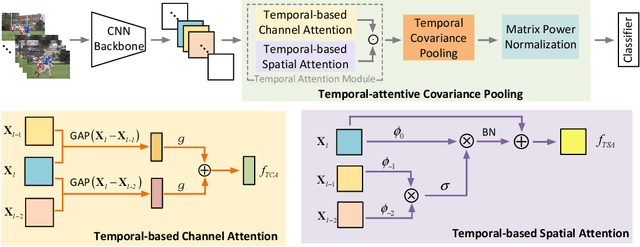

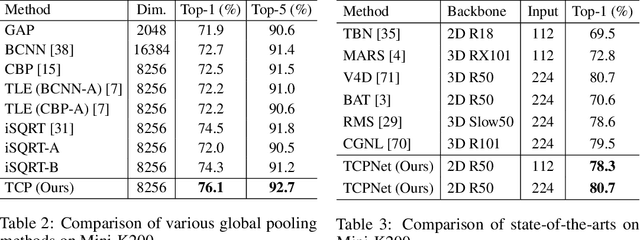

Abstract:For video recognition task, a global representation summarizing the whole contents of the video snippets plays an important role for the final performance. However, existing video architectures usually generate it by using a simple, global average pooling (GAP) method, which has limited ability to capture complex dynamics of videos. For image recognition task, there exist evidences showing that covariance pooling has stronger representation ability than GAP. Unfortunately, such plain covariance pooling used in image recognition is an orderless representative, which cannot model spatio-temporal structure inherent in videos. Therefore, this paper proposes a Temporal-attentive Covariance Pooling(TCP), inserted at the end of deep architectures, to produce powerful video representations. Specifically, our TCP first develops a temporal attention module to adaptively calibrate spatio-temporal features for the succeeding covariance pooling, approximatively producing attentive covariance representations. Then, a temporal covariance pooling performs temporal pooling of the attentive covariance representations to characterize both intra-frame correlations and inter-frame cross-correlations of the calibrated features. As such, the proposed TCP can capture complex temporal dynamics. Finally, a fast matrix power normalization is introduced to exploit geometry of covariance representations. Note that our TCP is model-agnostic and can be flexibly integrated into any video architectures, resulting in TCPNet for effective video recognition. The extensive experiments on six benchmarks (e.g., Kinetics, Something-Something V1 and Charades) using various video architectures show our TCPNet is clearly superior to its counterparts, while having strong generalization ability. The source code is publicly available.
Global Second-order Pooling Convolutional Networks
Nov 30, 2018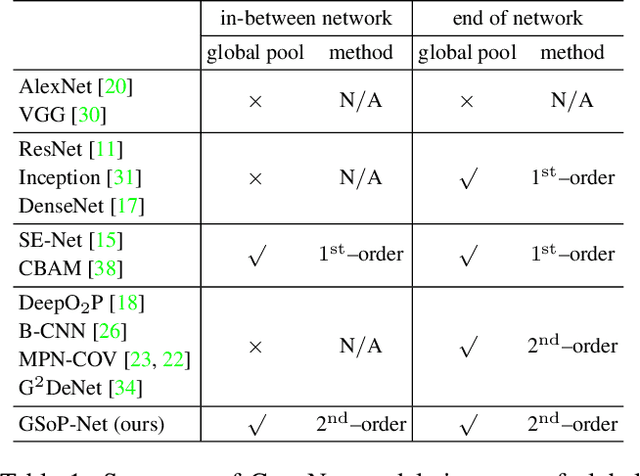

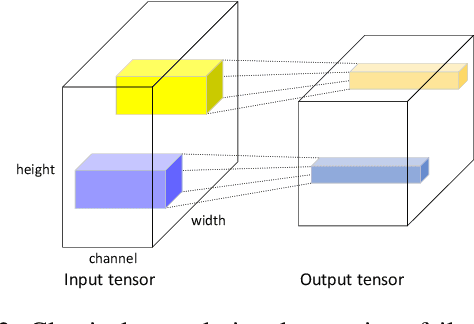
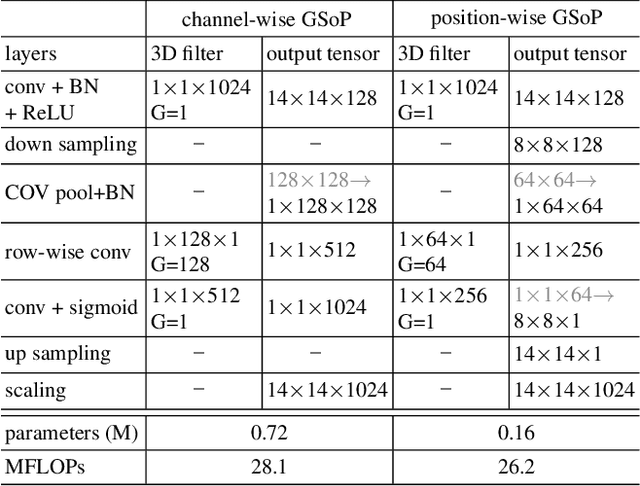
Abstract:Deep Convolutional Networks (ConvNets) are fundamental to, besides large-scale visual recognition, a lot of vision tasks. As the primary goal of the ConvNets is to characterize complex boundaries of thousands of classes in a high-dimensional space, it is critical to learn higher-order representations for enhancing non-linear modeling capability. Recently, Global Second-order Pooling (GSoP), plugged at the end of networks, has attracted increasing attentions, achieving much better performance than classical, first-order networks in a variety of vision tasks. However, how to effectively introduce higher-order representation in earlier layers for improving non-linear capability of ConvNets is still an open problem. In this paper, we propose a novel network model introducing GSoP across from lower to higher layers for exploiting holistic image information throughout a network. Given an input 3D tensor outputted by some previous convolutional layer, we perform GSoP to obtain a covariance matrix which, after nonlinear transformation, is used for tensor scaling along channel dimension. Similarly, we can perform GSoP along spatial dimension for tensor scaling as well. In this way, we can make full use of the second-order statistics of the holistic image throughout a network. The proposed networks are thoroughly evaluated on large-scale ImageNet-1K, and experiments have shown that they outperformed non-trivially the counterparts while achieving state-of-the-art results.
Towards Faster Training of Global Covariance Pooling Networks by Iterative Matrix Square Root Normalization
Apr 01, 2018

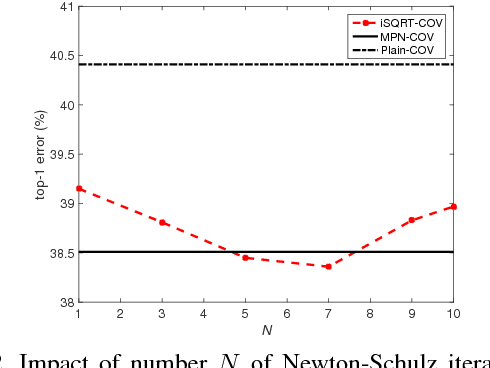
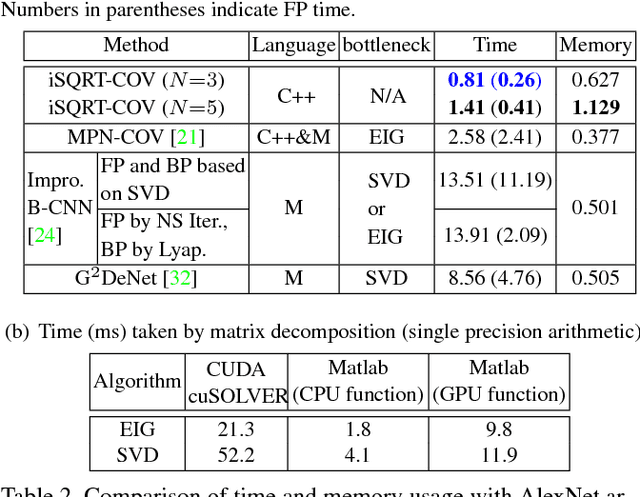
Abstract:Global covariance pooling in convolutional neural networks has achieved impressive improvement over the classical first-order pooling. Recent works have shown matrix square root normalization plays a central role in achieving state-of-the-art performance. However, existing methods depend heavily on eigendecomposition (EIG) or singular value decomposition (SVD), suffering from inefficient training due to limited support of EIG and SVD on GPU. Towards addressing this problem, we propose an iterative matrix square root normalization method for fast end-to-end training of global covariance pooling networks. At the core of our method is a meta-layer designed with loop-embedded directed graph structure. The meta-layer consists of three consecutive nonlinear structured layers, which perform pre-normalization, coupled matrix iteration and post-compensation, respectively. Our method is much faster than EIG or SVD based ones, since it involves only matrix multiplications, suitable for parallel implementation on GPU. Moreover, the proposed network with ResNet architecture can converge in much less epochs, further accelerating network training. On large-scale ImageNet, we achieve competitive performance superior to existing counterparts. By finetuning our models pre-trained on ImageNet, we establish state-of-the-art results on three challenging fine-grained benchmarks. The source code and network models will be available at http://www.peihuali.org/iSQRT-COV
 Add to Chrome
Add to Chrome Add to Firefox
Add to Firefox Add to Edge
Add to Edge